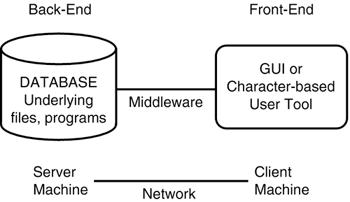 | The previous hour covered some advanced SQL topics. These topics built on earlier hours in the book and began to show you practical applications for the SQL you have learned. During this hour, you focus on the concepts behind extending SQL to the enterprise, which involve SQL applications and making data available to all appropriate members of a company for daily use. Many commercial enterprises have specific data available to other enterprises , customers, and vendors . For example, the enterprise may have detailed information on its products available for customers' access in hopes of acquiring more purchases. Enterprise employee needs are included as well. For example, employee-specific data can also be made available, such as for timesheet logs, vacation schedules, training schedules, company policies, and so on. A database can be created, and customers and employees can be allowed easy access to an enterprise's important data via SQL and an Internet language. | The Back End  | The heart of any application is the back-end application. This is where things happen behind the scenes, transparent to the database end user . The back-end application includes the actual database server, data sources, and the appropriate middleware used to connect an application to the Web or a remote database on the local network. |  | As a review, some of the major database servers include Oracle, Informix, Sybase, Microsoft SQL Server, and Borland InterBase. This is typically the first step in porting any application, either to the enterprise through a local area network (LAN), to the enterprise's own intranet, or to the Internet. Porting describes the process of implementing an application in an environment that is available to users. The database server should be established by an onsite database administrator who understands the company's needs and the application's requirements. | The middleware for the application includes a Web server and a tool capable of connecting the Web server to the database server. The main objective is to have an application on the Web that can communicate with a corporate database. The Front-End Application  | The front-end application is the part of an application with which an end user interacts . The front-end application is either a commercial, off-the-shelf software product that a company purchases, or an application that is developed in-house using other third-party tools. Commercial software can include Web browsers such as Netscape Navigator or Internet Explorer. In the Web environment, browsers are often used to database applications. Third-party tools are those described in the following paragraphs. | Before the rise of many of the new front-end tools available today, users had to know how to program in languages such as C++, HTML, or one of many other procedural programming languages that develop Web-based applications. Other languages, such as ANSI C, COBOL, FORTRAN, and Pascal, have been used to develop front-end, onsite corporate applications, which were mainly character-based. Today, most newly developed front-end applications have a graphical user interface (GUI). The tools available today are user-friendly and object-oriented, by way of icons, wizards, and dragging and dropping with the mouse. Some of the popular tools to port applications to the Web include C++Builder and IntraBuilder by Borland and Microsoft's Visual J++ and C++. Other popular applications used to develop corporate-based applications on a LAN include PowerBuilder by Powersoft, Oracle Designer and Forms by Oracle Corporation, Visual Basic by Microsoft, and Delphi by Borland. Today, many applications are also being developed using Java and JavaScript.  | The front-end application promotes simplicity for the database end user. The underlying database, code, and events that occur within the database are transparent to the user. The front-end application is developed to relieve the end user from guesswork and confusion, which may otherwise be caused by having to be too intuitive to the system itself. The new technologies allow the applications to be more intuitive, enabling the end users to focus on the true aspects of their particular jobs, thereby increasing overall productivity. |
Figure 23.1 illustrates the back-end and front-end components of a database application. The back end resides on the host server, where the database resides. Back-end users include developers, programmers, database administrators, system administrators, and system analysts. The front-end application resides on the client machine, which is typically each end user's PC. End users are the vast audience for the front-end component of an application, which can include users such as data entry clerks and accountants . The end user is able to access the back-end database through a network connectioneither a local area network (LAN) or a wide area network (WAN). Some type of middleware (such as an ODBC driver) is used to provide a connection between the front and back ends through the network. Figure 23.1. A database application.  |

